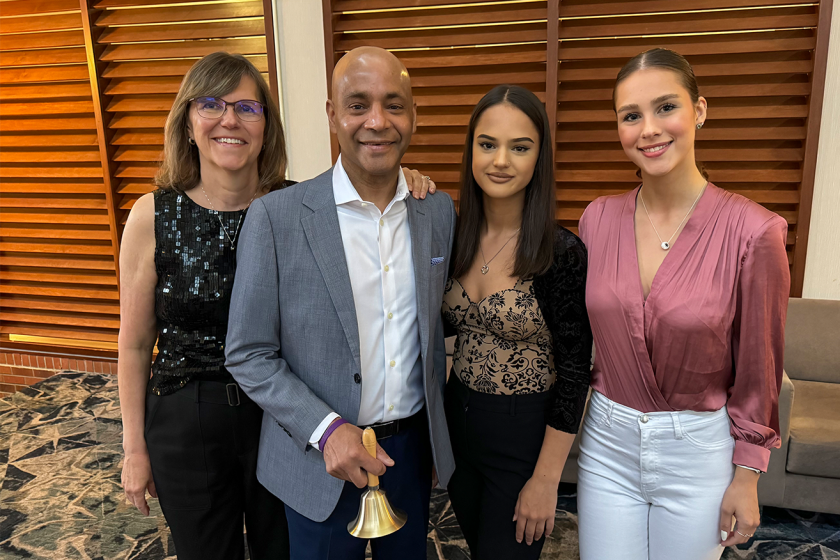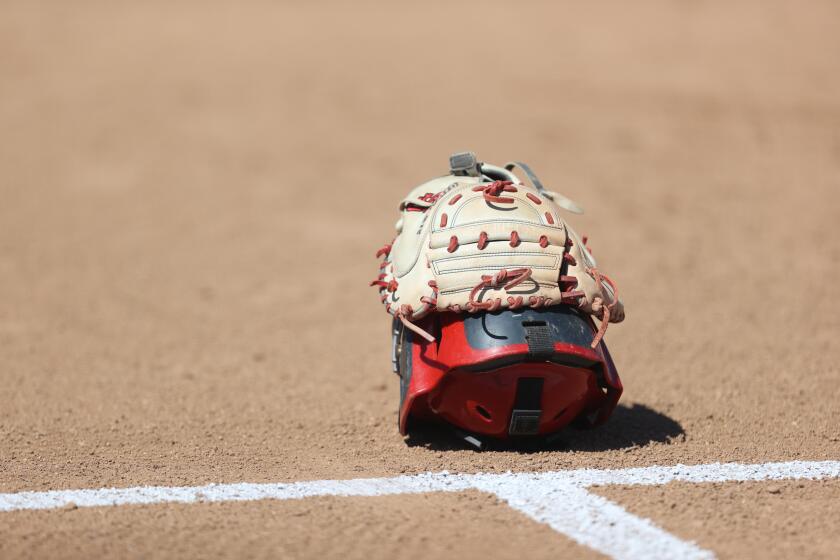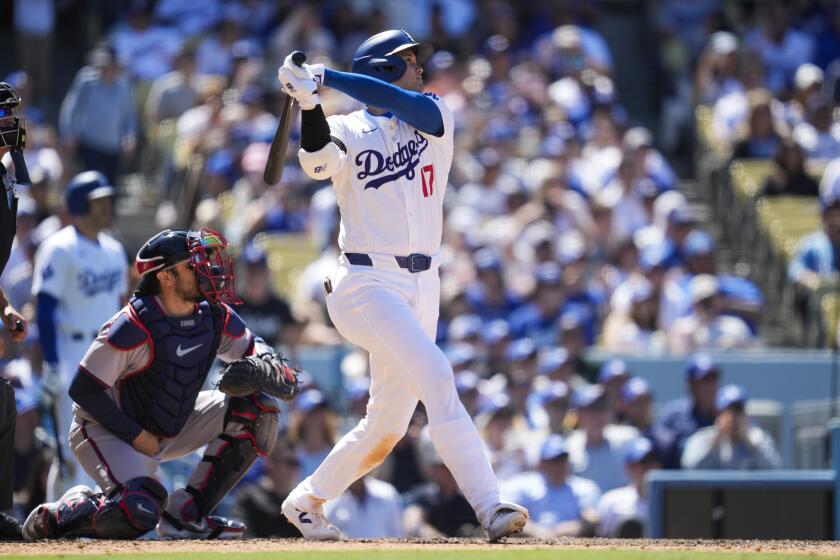Commentary : Too Many Fouls--Off the Court
College basketball has returned for a season that had better be better than the one that preceded it. You’d have to be some optimist to believe it will be.
The game is adrift on a sea of scandal. Perhaps never before has there been anything to approach the aggregate mountain of sleaze: the messy recruiting cases of John Williams and Tito Horford; the Tulane point-shaving and drug revelations; the Memphis State gambling grand jury; the Chris Washburn arrest and suspension revelations, and now, the Kentucky payoff admissions.
Item: In 1982, LSU assistant Ron Abernathy, on a trip to nearby Gulfport, Miss., to recruit Kenny Jimerson, the state’s player of the year, reports the theft of a briefcase with $2,000 cash in it from the front seat of his unlocked van.
A youth is later arrested. Mississippi Circuit Judge James Thomas, hearing the case, sentences the defendant, but makes public his suspicions about the complainant. Thomas directs that a transcript of the trial be forwarded to the NCAA.
LSU holds its own investigation, and accepts Abernathy’s explanation--he was out paying bills in Baton Rouge when he got an emergency phone call to make a recruiting trip.
“Quite obviously, LSU wasn’t outraged,” Thomas said Tuesday. “No one from LSU came over for the trial. No one seemed to be particularly concerned. It smelled.”
A total of $1,100--all in $100 and $50 bills--was recovered and taken into evidence. A certified check for that amount was mailed to Abernathy, who wrote back, thanking the officials.
“He never did complain about the difference,” Thomas said.
Item: In 1984, LSU Coach Dale Brown tells of asking the chancellor of the university, James Wharton, for permission to put $150,000 in a briefcase and offer it to John Williams of Crenshaw High School in Los Angeles, just to drive home the meat-market aspect of it. Brown says he’s been told that Williams has been offered that much by other schools.
Wharton turns him down, saying the offer might be misinterpreted, thus proving that everyone at LSU isn’t completely out of his gourd.
Just the usual bayou madness? There’s a lot of madness out there.
Item: in the wake of the Kentucky story, three young Philadelphia 76ers, Charles Barkley, Terry Catledge and Leon Wood, tell of offers they received during recruitment. Wood says he got a car at his first school, Arizona, and took it with him when he transferred to Cal State Fullerton.
“I didn’t figure they’d be coming after it,” Wood told the Philadelphia Inquirer’s Bill Lyon. “And they didn’t.”
Only the price seems to be going up. The hiring of athletes by colleges and/or boosters is nothing new, apparently having begun shortly after Dr. Naismith came down the ladder from his peach basket.
Remember Moses Malone, an incoming University of Maryland freshman, posing for a picture on the hood of his new Chrysler, acquired on a “lease-purchase” deal?
Malone then signed an ABA contract, and departed without attending a day of school. Coach Lefty Driesell, determined to salvage something, still lists him in his yearbook among the players the Terrapins have sent to the pros.
And lest anyone forget Wilt Chamberlain, he recently came forward to remind everyone that he, too, had received illicit payments at Kansas.
Questions arise: Who really cares? They’re all doing it, aren’t they? So some kids get a few bucks or a sweetheart deal on a car, who’s really getting hurt?
Everyone gets hurt. Everyone is tarred by the stigma. Everything good about the game is cheapened if it rests on a foundation of half-truths, cynicism and a final commitment to nothing but individual self-advancement.
Every coach in the nation claims to despise what’s going on--at everyone else’s school. It’s all they ever talk about--off the record.
The problem, however, is the system. It was built for abuse and is only realizing its potential.
Winning teams generate huge prestige and revenue for the schools, especially in the form of increased alumni donations, and excitement for boosters.
Even one blue-chipper can “turn the program around.”
Every school wants him.
He’s just a high school kid with relatively cheap tastes, so he doesn’t cost much.
Guess what comes next.
The system is now almost womb to tomb.
What we’ve got is a new sophistication everywhere:
--Recruitment by agents. World B. (nee Lloyd) Free was picked up by his first agent, Joe Jeffries-El, when Free was a teen-ager playing in Brooklyn’s Brownsville schoolyards.
--Recruitment by junior high schools.
--Recruitment by high schools.
--Recruitment by summer camps, which offer “scholarships” and do-little jobs and guaranteed exposure to big-time college coaches.
--Fame, in the form of inclusion on the national lists that are swapped back and forth by some newspaper high-school writers and assorted bird-dogs, who rank players they may never have seen, with such memorable descriptions as, “Pure blue-chipper. . . . Moses will lead some school to the promised land. . . . Sampson is mighty.”
--The high school all-star game circuit. Big cities, big arenas (Capital Center, Pauley Pavilion), big exposure for your blue-chipper.
--Early recruitment by colleges. When he was in the ninth grade, Chris Washburn received his first note from Dean Smith of the cleaner than clean University of North Carolina. When he had just completed 10th grade, he got one from Jim Valvano, saying that Washburn could become an All-American and a first-round draft choice by enrolling at North Carolina State.
After encountering his own problems, Washburn allowed Sports Illustrated to see his correspondence. Included was this in a note from Coach Mike Krzyzewski of another prestigious school, Duke:
“You looked in great shape and the young lady with you did not hurt your appearance. She looked like a first class girl.”
--The player’s own “friends.” Many advisers and blood relatives are eager to help sort through the offers. A high school star may acquire an entourage of representatives and would-be representatives, some of whom the colleges may then try to enlist, by whatever means.
John Williams, whose inner circle would barely have fit in one living room, didn’t even appear at the press conference in Los Angeles announcing that he would attend LSU. Instead, a heretofore unknown man in a white Panama hat did. Sports Illustrated last week identified him as Stan Rothe, who runs a football gambling-tip service.
If all this doesn’t turn the player’s head into pudding, we’re talking about a special person, indeed.
And then comes college, when everyone discovers new experiences such as:
--Selling one’s season tickets. Don’t worry about having to stand out front of the arena, someone will find you a buyer. One Kentucky player, Jay Shidler, said he got $8,400 for his from Cecil Dunn, who was Coach Joe B. Hall’s lawyer. Hall denied all knowledge of same.
--Family participation. The blood relatives safeguard Junior’s pro prospects--real or in most cases wholly imaginary--by making sure he gets enough playing time and opportunities to shoot the rock. The coach, having spent an inordinate amount of time in their living room, is now called upon to return the favor by entertaining them in his office, if he wants to keep Junior from driving his sweetheart deal to some other school.
--Plea bargaining. When star center John Williams, of another highly respected academic institution, Tulane, was implicated in point-shaving, his attorney said that Williams had been given $10,000 in a shoe box to enroll. The scandal was enlarged to include the athletic department, the admissions office and Coach Ned Fowler, who resigned. The system thus has turned around and is devouring itself.
The NCAA is supposed to be policing this, but it could as easily march on the Soviet Union. The NCAA is a small umbrella organization, with an office outside Kansas City, a handful of investigators and no subpoena power.
In cases of mass malfeasance, it will move in an investigative team, question everyone in sight and discover a pattern of abuses, like someone getting a T-shirt he shouldn’t have, or an illegal ride from the airport.
The school, overcome with relief that nothing worse has been documented, accepts the resulting probations.
The T-shirt story is then leaked to the local press, which runs a 100-yard dash with it, making the school look like the puniest of offenders and the NCAA look silly. Everyone goes home with something.
The whole thing rests on a tacit understanding between the schools and the NCAA: You don’t hit us too hard and we won’t take you into court, which might knock down every rule in the NCAA Handbook.
Everyone is allowed the illusion that the system is really policeable, that all they have to do is tinker with a rule here and there, catch a couple of bandits, and everything will be all right.
The bandits, of course, keep slipping off the hook.
When those programs do happen to slip under judicial scrutiny, which has penalties for lying and jail sentences for conviction, amazing revelations often result. A coach’s worst nightmare has nothing to do with not getting back on defense, or an off-night shooting. It’s that the grand jury is looking at his program.
What can be done?
If there were an easy answer, someone might have gotten to it by now and things might be getting a little better, instead of much worse.
There are, however, places where it comes close to working as drawn up. Whether it’s a lesson for everyone is another question.
Indiana’s Bob Knight runs a clean program, operative word being runs. Boosters have no access to the Hoosier locker room and live in the knowledge that if they overstep their bounds, Knight will bite their heads off at the neck.
Knight, however, has his pick of prospects, based on his charisma and the fact that he wins. Players enroll knowing that they will be gods on campus, that he will make men of them or kill them trying, and that they will get national exposure.
But even Knight feels the heat. Last season, after Indiana missed the NCAA tournament, he stopped railing about his peers’ recruiting outrages and dropped his own longstanding ban on junior college players. One assumes that he can still run an exemplary program with them, but the response was interesting. As Knight could tell you, one bad season can take one hell of a toll on one’s charisma.
Someone out there has to lose. The challenge is finding out if anyone--much less everyone--is willing to run a clean program at the cost of winning.
There are other steps that might lessen the pressure all around:
--Multiply the number of NCAA investigators.
--Split the Final Four money among all the Division I schools, rather than the four finalists.
--Grant scholarships on the basis of graduated athletes, another of Knight’s ideas. If one of your scholarship players doesn’t get a degree, you lose one scholarship.
--Register players’ cars.
--Register their sources of income.
Nothing will work, though, until there is a real commitment among university presidents. Lip service notwithstanding, it still means more to some of them than to others.
More to Read
Get our high school sports newsletter
Prep Rally is devoted to the SoCal high school sports experience, bringing you scores, stories and a behind-the-scenes look at what makes prep sports so popular.
You may occasionally receive promotional content from the Los Angeles Times.






